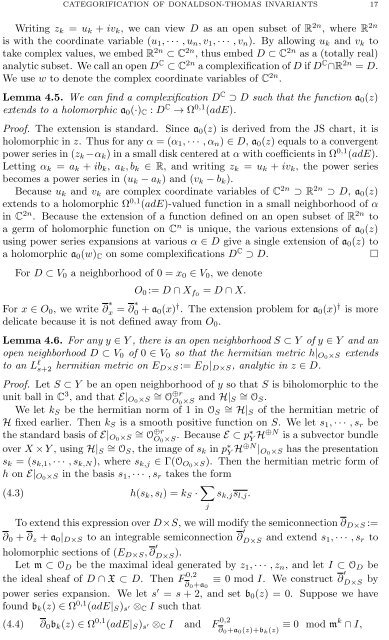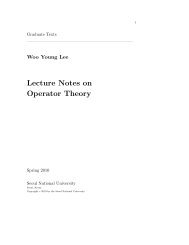Categorification of Donaldson-Thomas invariants via perverse ...
Categorification of Donaldson-Thomas invariants via perverse ...
Categorification of Donaldson-Thomas invariants via perverse ...
You also want an ePaper? Increase the reach of your titles
YUMPU automatically turns print PDFs into web optimized ePapers that Google loves.
CATEGORIFICATION OF DONALDSON-THOMAS INVARIANTS 17Writing z k = u k + iv k , we can view D as an open subset <strong>of</strong> R 2n , where R 2nis with the coordinate variable (u 1 , · · · , u n , v 1 , · · · , v n ). By allowing u k and v k totake complex values, we embed R 2n ⊂ C 2n , thus embed D ⊂ C 2n as a (totally real)analytic subset. We call an open D C ⊂ C 2n a complexification <strong>of</strong> D if D C ∩R 2n = D.We use w to denote the complex coordinate variables <strong>of</strong> C 2n .Lemma 4.5. We can find a complexification D C ⊃ D such that the function a 0 (z)extends to a holomorphic a 0 (·) C : D C → Ω 0,1 (adE).Pro<strong>of</strong>. The extension is standard. Since a 0 (z) is derived from the JS chart, it isholomorphic in z. Thus for any α = (α 1 , · · · , α n ) ∈ D, a 0 (z) equals to a convergentpower series in (z k −α k ) in a small disk centered at α with coefficients in Ω 0,1 (adE).Letting α k = a k + ib k , a k , b k ∈ R, and writing z k = u k + iv k , the power seriesbecomes a power series in (u k − a k ) and (v k − b k ).Because u k and v k are complex coordinate variables <strong>of</strong> C 2n ⊃ R 2n ⊃ D, a 0 (z)extends to a holomorphic Ω 0,1 (adE)-valued function in a small neighborhood <strong>of</strong> αin C 2n . Because the extension <strong>of</strong> a function defined on an open subset <strong>of</strong> R 2n toa germ <strong>of</strong> holomorphic function on C n is unique, the various extensions <strong>of</strong> a 0 (z)using power series expansions at various α ∈ D give a single extension <strong>of</strong> a 0 (z) toa holomorphic a 0 (w) C on some complexifications D C ⊃ D.□For D ⊂ V 0 a neighborhood <strong>of</strong> 0 = x 0 ∈ V 0 , we denoteO 0 := D ∩ X f0 = D ∩ X.For x ∈ O 0 , we write ∂ ∗ x = ∂ ∗ 0 + a 0 (x) † . The extension problem for a 0 (x) † is moredelicate because it is not defined away from O 0 .Lemma 4.6. For any y ∈ Y , there is an open neighborhood S ⊂ Y <strong>of</strong> y ∈ Y and anopen neighborhood D ⊂ V 0 <strong>of</strong> 0 ∈ V 0 so that the hermitian metric h| O0×S extendsto an L l s+2 hermitian metric on E D×S := E D | D×S , analytic in z ∈ D.Pro<strong>of</strong>. Let S ⊂ Y be an open neighborhood <strong>of</strong> y so that S is biholomorphic to theunit ball in C 3 , and that E| ∼ O0×S = O ⊕rO and H| ∼ 0×S S = O S .We let k S be the hermitian norm <strong>of</strong> 1 in O S∼ = H|S <strong>of</strong> the hermitian metric <strong>of</strong>H fixed earlier. Then k S is a smooth positive function on S. We let s 1 , · · · , s r bethe standard basis <strong>of</strong> E| ∼ O0×S = O ⊕rO . Because E ⊂ 0×S p∗ Y H⊕N is a subvector bundleover X × Y , using H| S∼ = OS , the image <strong>of</strong> s k in p ∗ Y H⊕N | O0×S has the presentations k = (s k,1 , · · · , s k,N ), where s k,j ∈ Γ(O O0×S). Then the hermitian metric form <strong>of</strong>h on E| O0×S in the basis s 1 , · · · , s r takes the form(4.3) h(s k , s l ) = k S · ∑s k,j s l,j .To extend this expression over D×S, we will modify the semiconnection ∂ D×S :=∂ 0 + ∂ z + a 0 | D×S to an integrable semiconnection ∂ ′ D×S and extend s 1 , · · · , s r toholomorphic sections <strong>of</strong> (E D×S , ∂ ′ D×S).Let m ⊂ O D be the maximal ideal generated by z 1 , · · · , z n , and let I ⊂ O D bethe ideal sheaf <strong>of</strong> D ∩ X ⊂ D. Then F 0,2 ≡ 0 mod I. We construct ∂ ′ ∂ 0+a 0D×S bypower series expansion. We let s ′ = s + 2, and set b 0 (z) = 0. Suppose we havefound b k (z) ∈ Ω 0,1 (adE| S ) s ′ ⊗ C I such that(4.4) ∂ 0 b k (z) ∈ Ω 0,1 (adE| S ) s ′ ⊗ C I and F 0,2∂ 0+a 0(z)+b k (z) ≡ 0 mod mk ∩ I,j













